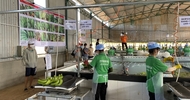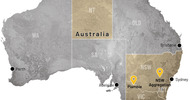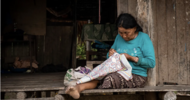PR Insider | 20 October 2009 | NB: This is a commercial pitch for foreign investment in Ukranian farmland. It is being posted here merely if people want to see how such deals are advertised.
Soft Commodities – Investment in a Strategic Material One of the main engines behind the rise in soft commodity investment is world hunger. An ever-increasing global population means more mouths to feed, which in turn means more land (e.g. in Ukraine) must be farmed. China is one of the many countries with a food security problem. The Asiatic giant faces a major challenge to feed one fifth of the world’s population with less than one tenth of its farmlands. Unsurprisingly, China is increasingly turning to food imports, particularly grain and soya. In the future, these crops are expected to be mainly sourced from the grain-countries of the future. Ukraine agricultural land with its rich and fertile soil is likely to become one of China’s (and the world’s) main grain providers. At the moment, China is self-sufficient in food. Intensive agricultural methods and improved farming techniques – also being applied on Ukraine land – mean China is able to produce all of its current grain requirements (around 5.3 million tonnes). But self-sufficiency is fast becoming unsustainable because of changes in Chinese demographics. Not only is the Chinese population growing, the rural population is falling as more and more Chinese move to cities in search of a higher standard of living. Since the early 1950’s, China’s urban population has grown by over a third. “China is facing many new food security challenges as a result of rapid urbanisation and industrialisation,” says Yin Chengjie, Vice-Chairman of the Agriculture and Rural Affairs Committee. The huge migration to cities has led to the urbanisation of large areas of China with the resulting loss in farmland. According to Mr Chengjie, because of industrialisation, some parts of China have gone from food self-sufficiency to net importers of grain. As well as the decrease in available agricultural land, lack of water is also a problem for Chinese farmers. Drought accounts for a large percentage of loss in grain production. Further strains on the food chain come from changes in diet, particularly among city-dwellers. The Chinese urban diet now includes higher proportions of meat, eggs and milk, all products that are dependent on grain as animal feed. In the words of Mr Chengjie, “grain is not only a commodity, but also a strategic material for a country of 1.3 billion people”.Feeding this huge population is not going to get any easier and many experts believe that China will be increasingly dependent on foreign grain imports in order to feed its people. These grain imports are expected to come from traditional grain producers such as the US and the EU, but also from up-and-coming countries with reserves of agricultural land. Ukraine, along with Russia and Kazakhstan, are prime examples. Ukraine has large areas of unexploited agricultural land, which are gradually being farmed for grain. The combination of highly-fertile soil, excellent growing conditions and improved farming techniques gives Ukraine agricultural land the potential to vastly increase its yield. With hungry countries desperately in need of food, Ukraine land certainly provides the vehicle for a strategic investment in soft commodities.Who's involved?
Whos Involved?
13 May 2024 - Washington DC
World Bank Land Conference 2024
Languages
- Amharic
- Bahasa Indonesia
- Català
- Dansk
- Deutsch
- English
- Español
- français
- Italiano
- Kurdish
- Malagasy
- Nederlands
- Português
- Suomi
- Svenska
- Türkçe
- العربي
- 日本語
Special content
Archives
Latest posts
-

HAGL raises $51mln from private placement
- VNN
- 22 April 2024
-

Pakistan sweetens terms to lure Saudi investment
- Tribune
- 20 April 2024












